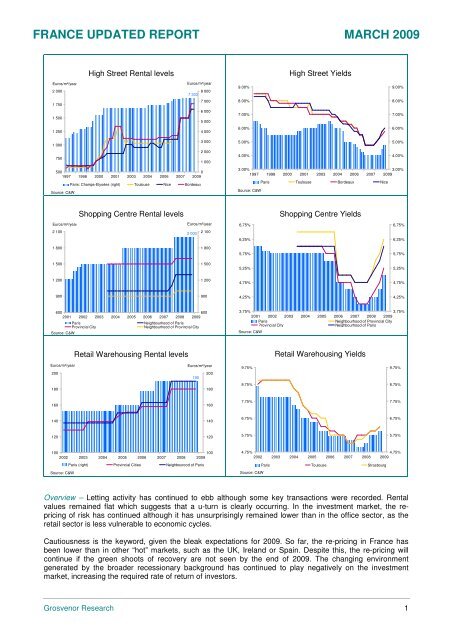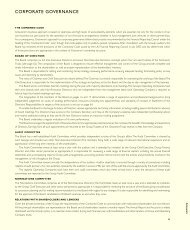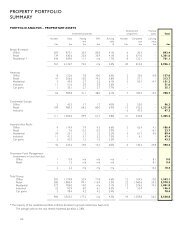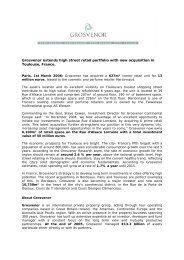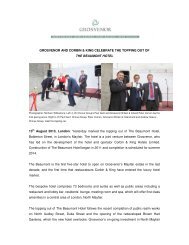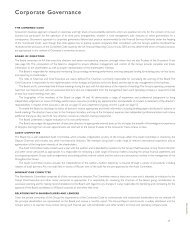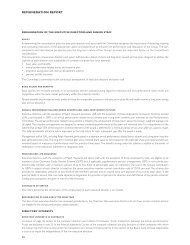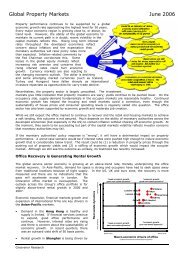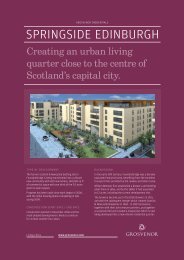FRANCE UPDATED REPORT MARCH 2009 - Grosvenor
FRANCE UPDATED REPORT MARCH 2009 - Grosvenor
FRANCE UPDATED REPORT MARCH 2009 - Grosvenor
Create successful ePaper yourself
Turn your PDF publications into a flip-book with our unique Google optimized e-Paper software.
<strong>FRANCE</strong> <strong>UPDATED</strong> <strong>REPORT</strong> <strong>MARCH</strong> <strong>2009</strong><br />
High Street Rental levels<br />
High Street Yields<br />
Euros/m²/year<br />
2 000<br />
1 750<br />
Euros/m²/year<br />
8 000<br />
7 303<br />
7 000<br />
9.00%<br />
8.00%<br />
9.00%<br />
8.00%<br />
1 500<br />
6 000<br />
5 000<br />
7.00%<br />
7.00%<br />
1 250<br />
4 000<br />
6.00%<br />
6.00%<br />
3 000<br />
1 000<br />
2 000<br />
750<br />
1 000<br />
500<br />
0<br />
1997 1998 2000 2001 2003 2004 2006 2007 <strong>2009</strong><br />
Paris: Champs-Elysées (right) Toulouse Nice Bordeaux<br />
Source: C&W<br />
5.00%<br />
5.00%<br />
4.00%<br />
4.00%<br />
3.00%<br />
3.00%<br />
1997 1998 2000 2001 2003 2004 2006 2007 <strong>2009</strong><br />
Paris Toulouse Bordeaux Nice<br />
Source: C&W<br />
Shopping Centre Rental levels<br />
Shopping Centre Yields<br />
Euros/m²/year<br />
Euros/m²/year<br />
6,75%<br />
6,75%<br />
2 100<br />
2 000<br />
2 100<br />
6,25%<br />
6,25%<br />
1 800<br />
1 800<br />
5,75%<br />
5,75%<br />
1 500<br />
1 500<br />
5,25%<br />
5,25%<br />
1 200<br />
1 200<br />
4,75%<br />
4,75%<br />
900<br />
900<br />
4,25%<br />
4,25%<br />
600<br />
600<br />
2001 2002 2003 2004 2005 2006 2007 2008 <strong>2009</strong><br />
Source: C&W<br />
Paris<br />
Provincial City<br />
Neighbourhood of Paris<br />
Neighbourhood of Provincial City<br />
3,75%<br />
3,75%<br />
2001 2002 2003 2004 2005 2006 2007 2008 <strong>2009</strong><br />
Paris<br />
Neighbourhood of Provincial City<br />
Provincial City<br />
Neighbourhood of Paris<br />
Source: C&W<br />
Retail Warehousing Rental levels<br />
Retail Warehousing Yields<br />
Euros/m²/year<br />
200<br />
Euros/m²/year<br />
200<br />
190<br />
9.75%<br />
9.75%<br />
180<br />
180<br />
8.75%<br />
8.75%<br />
160<br />
160<br />
7.75%<br />
7.75%<br />
140<br />
140<br />
6.75%<br />
6.75%<br />
120<br />
120<br />
5.75%<br />
5.75%<br />
100<br />
100<br />
2002 2003 2004 2005 2006 2007 2008 <strong>2009</strong><br />
Source: C&W<br />
Paris (right) Provincial Cities Neighbourood of Paris<br />
4.75%<br />
Source: C&W<br />
4.75%<br />
2002 2003 2004 2005 2006 2007 2008 <strong>2009</strong><br />
Paris Toulouse Strasbourg<br />
Overview – Letting activity has continued to ebb although some key transactions were recorded. Rental<br />
values remained flat which suggests that a u-turn is clearly occurring. In the investment market, the repricing<br />
of risk has continued although it has unsurprisingly remained lower than in the office sector, as the<br />
retail sector is less vulnerable to economic cycles.<br />
Cautiousness is the keyword, given the bleak expectations for <strong>2009</strong>. So far, the re-pricing in France has<br />
been lower than in other “hot” markets, such as the UK, Ireland or Spain. Despite this, the re-pricing will<br />
continue if the green shoots of recovery are not seen by the end of <strong>2009</strong>. The changing environment<br />
generated by the broader recessionary background has continued to play negatively on the investment<br />
market, increasing the required rate of return of investors.<br />
<strong>Grosvenor</strong> Research 1
Economic Updated<br />
The French Retail Market<br />
Retailer Demand – The letting market ran out of steam in Q4 2008, in line with the drastic slowdown. In spite<br />
of this feature, there were interesting transactions within the high street submarkets. The luxury brand took a<br />
large premise in the Champs-Elysées. Guess settled in Place de l’Opéra, the shoe maker Repetto took a<br />
scheme in the trendy 6 th district while Marc Jacobs and Stuart Weitzmann took premises in Saint-Honoré.<br />
The trendy Corto Moltedo has launched a flagship store in the Gallery of the Palais Royal, a luxury location.<br />
Despite such a move, the luxury “conquest” observed over the past few years is now fading. Most luxury<br />
groups have reported large decreases in sales since H2 2008, causing a drop in earnings. Therefore, luxury<br />
companies have announced a cost cutting in overheads as well as a reduction in their expansion plans. This<br />
should not come as unexpected, as most of our past empirical studies emphasized the volatility of the luxury<br />
sector, and its downside risks during a downturn. In prime Paris, some new recent fashion designers closed<br />
their units in the wake of the downturn, unable to stand the storm. Retailers are now definitely conscious that<br />
consumers are becoming more price conscious than ever, substituting goods as their budget constraint has<br />
now shifted downward.<br />
Okaïdi, Multimarques, Sprint and other mid market brands also took premises in the High Street shop<br />
submarket. In general, mass markets have shown more resilience to the downturn. In spite of that, they have<br />
also adopted a cautious stance, by freezing potential expansion, to avoid a cannibalization effect in the<br />
future.<br />
Short term indicators continue to trend downward as<br />
concerns are rising. The erosion of household<br />
expenditure, combined with rising unemployment and<br />
loss of income are marring retailer perceptions as a<br />
whole. Sales in department stores have touched a<br />
peak and are slowing down. Conversely,<br />
Supermarkets and Hypermarkets are holding well<br />
given their competitive edge in term or pricing.<br />
Altogether, prospects of future sales are deteriorating<br />
while inventories have globally increased, which does<br />
not bode well for the near term. Breaking down the<br />
retailer’s confidence index the biggest fall is related to<br />
the traditional “expansive” goods, those either related<br />
to big tickets items such as home goods or those<br />
linked to personal care or leisure activities. On a<br />
further negative note, surveys done in both the<br />
Percentage change year-on-year<br />
5<br />
0<br />
-5<br />
-10<br />
-15<br />
-20<br />
-25<br />
-30<br />
-35<br />
-35<br />
1996 1998 2000 2002 2004 2006 <strong>2009</strong><br />
Source: Global Insight.<br />
Retailers continued to droop<br />
as confidence worsens<br />
Consumer confidence index<br />
Retailer Confidence<br />
shopping centre and the department store submarkets have sharply deteriorated: lingering concerns are<br />
related to the household purchasing power. Tenants confess that the discounting price policy should remain<br />
a cornerstone strategy to boost turnover in the months ahead.<br />
Global retailer turnovers seem to have been resilient – although<br />
December data is not yet available. In spite of this, large<br />
differences remain across subsectors with fashion and footwear<br />
hardly hit. In <strong>2009</strong>, the global turnover is set to decrease in the<br />
wake of a worsening background, more “pain and tears” are<br />
expected as effort ratio are likely to increase further. Occupier<br />
demand is likely to fall, and retailers will definitely pressure<br />
landlords for more commercial incentives.<br />
Supply – According to Procos, a record 8.8 million m² of retail<br />
space is in the pipeline although some might be frozen along<br />
the way. The supply related to town centre regeneration is worth<br />
mentioning, including La Samaritaine redevelopment (26 000<br />
m²) located near the Seine in Paris, some units located in the<br />
Champs-Elysées (6 000 m²), as well as the Théâtre de l’Empire<br />
located in Paris. In the retail warehousing submarket, the top 5<br />
new openings comprise almost 150 000 m², while the main<br />
pipeline for <strong>2009</strong> are located in Provincial areas totalling more<br />
than 170 000 m². The 5 main projects relateing to shopping<br />
centres comprise 202 000 m². Again, an emphasis on retail<br />
parks as well as the new “green spirit” combining architectural<br />
design, price consciousness and high supply of retailers, has<br />
Percent<br />
10<br />
5<br />
0<br />
-5<br />
-10<br />
-15<br />
-20<br />
-25<br />
-30<br />
<strong>Grosvenor</strong> Research 2
Economic Updated<br />
The French Retail Market<br />
expanded steadily around the big agglomerations.<br />
However, as retailers warn of a bleak outlook, some developments have been postponed or cancelled,<br />
particularly in the provinces. Procos has already announced the cancellation of more than 800 000 m²<br />
between January 2008 and January <strong>2009</strong>, particularly in the retail park submarket.<br />
Despite poor short term economic prospects reform concerning building consents in early August will allow<br />
new opportunities, especially for downtown developments. The new law which allows the opening of<br />
premises up to 1 000 m² without a building consent (as explained in past reports), might benefit its<br />
application decree does not specify whether it is related to new or old retail space. Therefore, supermarkets<br />
and other large scale stores took advantage of this loophole to push out “their walls” and enlarge their<br />
current store area, a real opportunity for them as their turnover is gaining momentum at a fast pace.<br />
Rental Movements – As expected in past reports, the rental growth increase was not sustainable. Rental<br />
values remained flat across all submarkets in France in Q4 2008. Altogether, rents slowed down to 7% in<br />
2008 compared with 10% in 2007, below the average growth since 1996. We continue to forecast that a<br />
downward adjustment will be seen in the wake of lower spending and an increasing effort ratio. Our<br />
prediction remains that luxury prime schemes will suffer first given the higher volatility of their turnover (refer<br />
to the report written in November 2007). Again, although no drop has been reported so far, commercial<br />
incentives are on the rise, especially lease renewals.<br />
In the SC sector, rents remained stable while on an annual basis rents increased by 9% in 2008 compared<br />
with 2007. Such a rebound is a mitigating effect of the past change in the indexation mechanism: as rents<br />
have been indexed at a lower rate through the ILC than the CCI, the market rent has been able to renew<br />
with a positive trend. Nonetheless, the bright picture will not last as SC have been suffering from a fall in<br />
traffic for couple of quarters. All in all, the shift from the CCI to the new ILC, is not anymore restricted to the<br />
SC tenants. The new popular ILC is spreading at a fast pace and used by landlords as a favour to avoid any<br />
rental value decrease when leases have to be renewed. Nonetheless, as the CCI is expected to decrease in<br />
the wake of the huge drop in commodity and oil prices, the shift from the CCI to the ILC is also a savvy<br />
means for landlords to avoid a drop in their income stream next year!<br />
No sea change has been seen within the retail warehousing submarket. Such a sector usually remains less<br />
vulnerable in a downward phase of the cycle than both shopping centres and the high street. The downward<br />
adjustment of rental values is certain given the current downward trajectory of the global turnover growth<br />
driven by a slowdown in private consumption. The diversity of the retail sector itself in term of (i) premises<br />
(either located in high street, shopping centre and retail warehousing) (ii) location in large or small<br />
agglomeration, (iii) existing supply, (iv) forthcoming supply, and (v) turnover of retailers currently open the<br />
spectrum of potential forecasts. As commercial incentives have hidden the potential drops – brokers confess<br />
an increasing share of confidential deals, meaning that the level of rents must not be released – more<br />
adjustment is set to be seen. As <strong>2009</strong> will be tough for retailers, households tightening their belts, our<br />
baseline scenario has not changed: in regional cities, downward corrections between -15% (where the<br />
highest increases have been observed) and -5% are likely.<br />
Investment Market – “Why should we buy today, as it<br />
will be cheaper tomorrow?” Such a tune may have<br />
Investment the Retail Market<br />
been the mantra of investors in <strong>2009</strong>. Indeed, the<br />
remaining fears of further falls in capital values in<br />
€ million<br />
6000<br />
<strong>2009</strong> have acted as a brake in the investment market,<br />
notably in Q4 2008. Altogether, the activity within the<br />
5000<br />
4800<br />
retail investment market decreased by almost 80% on<br />
the back of a wait and see stance of both buyers and<br />
sellers. Indeed, it has to be kept in mind that although<br />
4000<br />
3000<br />
2050<br />
the French market has not appeared to be poised for 2000<br />
1700<br />
crash, potential buyers have continued to adjust<br />
800<br />
950<br />
1100<br />
1100<br />
1000<br />
downwards their expectations in the wake of the<br />
dreadful environment. Practically, the active buyers 0<br />
2002 2003 2004 2005 2006 2007 2008<br />
are taking more time to structure deals but also put<br />
pressure on potential sellers as increasing credit<br />
S ource: Immostat<br />
conditions and guarantees have decreased their<br />
willingness to pay. More generally, domestic players continue to be in a good position to benefit from the<br />
downward adjustment (Insurance companies, SCPI –non listed real estate vehicles). Given their long term<br />
<strong>Grosvenor</strong> Research 3
Economic Updated<br />
The French Retail Market<br />
profile, they seem to be less vulnerable to a second round of downward adjustment as they highly favour<br />
regular and large income streams – rather than yield play. Such a reason explains their remaining strategy<br />
to hold core assets.<br />
As explained, since the beginning of the year, there has been a common expectation of a fall in capital<br />
values as a result of the financial turmoil. Such an environment has implied a “sell strategy” rather than a<br />
“hold one”. As noticed and anticipated, sellers have been reluctant to reduce their prices while buyers have<br />
taken an opportunistic stance with a hard-line approach: such a mismatch has continued to weigh on the<br />
pace of transactions. The sellers have also taken an opportunistic stance, as some of them have decided to<br />
hold back their assets when the bid price was not satisfying enough. As the domestic players have<br />
financially remained in good shape, no distress opportunities have been observed for prime assets like in<br />
other European countries, although some listed companies have undertaken some arbitrage to fulfil bank’s<br />
requirements. In the prime submarkets, the lack of sales activity continues to make it difficult to appraise<br />
prices, but valuers have taken a consensus view for the end of 2008.<br />
Yield movements across submarkets<br />
Moving now to some key market features, the<br />
downward adjustment in capital values has been<br />
1 Weighted-average of the different moves observed across cities.<br />
bps<br />
quicker in the high street submarket while an 125<br />
overshooting was observed both in the retail 100<br />
HS Paris<br />
HS Prov<br />
RW IDF<br />
RW Prov<br />
warehousing and shopping centres submarkets in Q4.<br />
75<br />
SC Paris + Prov SC Prov<br />
It is as if valuers wanted to catch-up the lag.<br />
50<br />
Altogether, in 2008 - as shown by the chart - the<br />
outward yield shift was the highest in the shopping<br />
centre submarket, while the high street shop<br />
25<br />
0<br />
-25<br />
1996 1998 2000 2002 2004 2006 2008<br />
submarket testified stronger resilience. In the high<br />
-50<br />
street shop submarket, the outward yield shift was<br />
-75<br />
between [75bps;125bps] which generates a capital<br />
value fall 1 of 19% on average. In the SC the yield shift<br />
-100<br />
Source: <strong>Grosvenor</strong> Research modelling, C&W<br />
was stronger [100bps;150bps] representing 22% on<br />
average. The stronger adjustment is not that<br />
surprising given the magnitude of the past yield compression. Finally, in the retail warehousing submarket,<br />
the outward move was between [50bps;100bps] which means a fall of 13% on average.<br />
With the recessionary phase is looming, consumption is set to lose momentum, dampening rental value<br />
growth potential. In such a setting, new capital value falls are set to be seen in <strong>2009</strong> and 2010, if no silver<br />
lining is seen from the real economic sphere by then. Although no negative wealth effect is foreseen<br />
compared with other countries, France will also have to fight against the headwinds if consumption falls<br />
below 1%.<br />
Key investments deals were undertaken between Q42008 and beginning of <strong>2009</strong>:<br />
In the High Street shop submarket:<br />
- Groupe Pierre and Entreprise acquired ‘Foncière du Marais’, a portfolio of 8 Parisian assets, (1,600<br />
m²) for €13m (8,125 €/m²).<br />
- A private investor acquired 6, Place de la Madeleine from Bluestone Group for €7.9m at a yield of<br />
5.07%.<br />
- A private investor acquired a forward-funded shopping centre investment and supermarket (1,535<br />
m²) in Rue de l’Arbalette, Reims for €7.4m.<br />
- Terrëis acquired a portfolio in Paris Rue Chabrol, Angers, Biarritz and Agde (918 m²) for €5.5m<br />
(5991 €/m²).<br />
- Sofidy acquired Naturalia in Paris 75011 (213 m²) for €1.2m (5,634 €/m²).<br />
- 231m² were acquired in Marseille, Boulevard Robert Schumann, for approximately 2,500 €/m².<br />
- A private investor acquired 47 Avenue de Saxe (330 m²) from Gécina for €1m (3,030 €/m²).<br />
<strong>Grosvenor</strong> Research 4
Economic Updated<br />
The French Retail Market<br />
In other submarkets:<br />
- AEW Immocommerical acquired a portfolio of 42 supermarkets under the brands Casino, Leader<br />
Price and Franprix from Casino Group for €80m.<br />
- Klémurs acquired a sale and lease-back of 21 King Jouet units (17,541 m²) for €18.3m, reflecting a<br />
net initial yield of 8.2%.<br />
- Klémurs acquired 6 units under construction in Châlon-sur-Saône (9,800 m²) for €14.8m reflecting a<br />
net initial yield of 6.6%.<br />
- Financière Teychené acquired a portfolio of medium-sized units in the East of France from Groupe<br />
Secyvest for €14.44m, reflecting a net initial yield of 6.75%-7%.<br />
- Placement Ciloger 1 OPCI acquired a forward-funded retail park retail park in Yvetot (7,000 m²), for<br />
€11m, reflecting a net initial yield of 6.5%.<br />
- Cenor Asset Management acquired a sale and leaseback of 6 Zolpan assets in the Ile de France<br />
region (12,680 m²) for €10m, reflecting a gross yield of approximately 9%.<br />
- A private investor acquired an asset at Noyelles Goudault (2,600 m²) for €5.18m, reflecting a net<br />
initial yield of 6%.<br />
- Financière Teychené acquired the Aubert and Picard units in Houdemont (1900 m²) from Secyvest<br />
for €2.9m.<br />
- Financière Teychené acquired 1,238m² in Bonneuil sur Marne for €2.95m.<br />
- Sofidy acquired La Halle and Le Dragon d’Or in Concarneau (1,067 m²) for €2.19m.<br />
- Financière Teychené acquired two assets let to La Halle and La Halle ô Chaussures in Commercy<br />
(2,000 m²) for €2.15m, reflecting a net initial yield of 8%.<br />
- Finexel acquired the Leader Price unit (1,484 m²) in Clermont Ferrand for €1.63m.<br />
- Immorente acquired Centre Auto Feu Vert at Saran, Orléans (1,280 m²) for €1.13m.<br />
- Uffi Ream bought from <strong>Grosvenor</strong> 10 500 m² of retail spaces in Villeneuve d’Ascq for €21.2 million<br />
reflected in a yield of 7.05%.<br />
- Mercialys bought from CCSO a part (2 850 m²) of “CC Geant Plein Ciel” (8 100 m²) in Narbonne.<br />
The total investment was €18 million, reflected in a yield of 5.6%.<br />
- Mercialys bought 2 700 m² out of the 18 000 m² of “CC Geant Casino” in Istres for €13 million,<br />
reflected in a yield of 5.4%.<br />
- Ciloger bought from Les Arches a Retail Park (8 000 m²) in Yvetot for €10.1 million, reflected in a<br />
yield of 6.3%.<br />
- One property fund represented by Cenor Asset Management acquired in sale and lease back<br />
operation 6 assets from Zolpan. The portfolio comprises 12 680 m² and was purchased for €10<br />
million.<br />
- Mercialys acquired from CCSO a part (2 300 m²) of “CC Géant Casino” in Lons for €8 million,<br />
reflected in a yield of 6.2%.<br />
<strong>Grosvenor</strong> Research 5
Economic Updated<br />
The French Retail Market<br />
GDP Slumped amid global recession fears<br />
% year-on-year<br />
5<br />
4<br />
150<br />
140<br />
Retail sales in value have lost momentum,<br />
more to come with easing inflation<br />
3<br />
130<br />
2<br />
1<br />
0<br />
-1<br />
120<br />
110<br />
100<br />
-2<br />
1991Q1 1994Q1 1997Q1 2000Q1 2003Q1 2006Q1 <strong>2009</strong> Q1<br />
90<br />
90 91 92 93 94 95 96 97 98 99 00 01 02 03 04 05 06 07 08<br />
Source: Global Insight<br />
GDP<br />
Private Consumption<br />
Retail Shops ( 3 mth ma) High Street & Popular Shops Supermarkets Hypermarkets<br />
Source: Banque de France<br />
5<br />
4<br />
3<br />
2<br />
1<br />
0<br />
-1<br />
-2<br />
Unemployment to rise spurs<br />
by a contracting Employment growth<br />
Percentage change year-on-year<br />
-3<br />
7<br />
1991Q1 1994Q1 1997Q1 2000Q1 2003Q1 2006Q1 <strong>2009</strong> Q1<br />
Employment<br />
Source: Global Insight.<br />
Rate of Unemployment (Right)<br />
Percent<br />
13<br />
12<br />
11<br />
10<br />
9<br />
8<br />
5<br />
0<br />
-5<br />
-10<br />
-15<br />
-20<br />
-25<br />
-30<br />
Consumer Confidence Index falling<br />
Retail sales lost momentum<br />
Percentage change year-on-year<br />
-35<br />
-2<br />
1996 1998 2000 2002 2004 2006 <strong>2009</strong><br />
Source: Global Insight.<br />
Consumer confidence index<br />
Retail sales (right scale)<br />
Percent<br />
6<br />
4<br />
2<br />
0<br />
Inflation declines<br />
as inflationary pressures ease<br />
% %<br />
4<br />
3<br />
8<br />
6<br />
2<br />
4<br />
1<br />
2<br />
0<br />
0<br />
-1<br />
-2<br />
-2<br />
2000 2001 2002 2003 2004 2005 2006 2007 2008 <strong>2009</strong><br />
Recession fears forced<br />
the ECB to cut rates<br />
% %<br />
10<br />
9<br />
12<br />
11<br />
8<br />
10<br />
9<br />
7<br />
8<br />
6<br />
7<br />
5<br />
6<br />
4<br />
5<br />
3<br />
4<br />
3<br />
2<br />
2<br />
1<br />
1<br />
0<br />
0<br />
1991 1993 1995 1997 1999 2001 2003 2005 2007 <strong>2009</strong><br />
Source: INSEE<br />
CPI<br />
Producer Prices Index<br />
Source: Banque de France<br />
10 year Gov't Bond Yields ECB Refi Rate<br />
Outlook Summary<br />
In 2008, economic activity slowed down to 0.8% the worst performance since the latest deepest crisis in<br />
1993. As expected France will soon enter into a recessionary phase. According to preliminary results, output<br />
growth contracted by 4.8% annualized rate, and by -1.0% on a year-on-year basis, as forecasted in the<br />
latest report. Therefore, the carry-over effect for <strong>2009</strong> is negative, confirming our baseline scenario that<br />
economic activity will contract vigorously in <strong>2009</strong>.<br />
Turning now to the breakdown by components, the picture is not encouraging as investment has been held<br />
back by 6% annualized rate in the wake of (i) tightening credit conditions and (ii) poor prospects in the near<br />
term. The high level of inventories does not bode well for future investment. Altogether, leading indicators<br />
<strong>Grosvenor</strong> Research 6
Economic Updated<br />
The French Retail Market<br />
and investment surveys have continued to be badly oriented, trending in a negative territory as companies<br />
do not see the end of the tunnel so far. Simulations suggest that investment, could contract by 10% in 2010<br />
pressuring deeply global domestic demand.<br />
The big question remains if the fiscal stimulus will be able to sustain economic activity as a whole. The<br />
government has decided to target sector, such as the car industry, instead of more global measures such as<br />
a decrease in VAT or income taxes rebates, like the UK did. Such a decision is mainly explained by the<br />
exposure of French GDP, as well as the overall French economic model, to the industry (16%). As the<br />
labour market is not as flexible as in the UK, companies have not been able to lay-off as many employees<br />
as they would have in a rationalization process. In such a context, the French government is sustaining<br />
companies to avoid any more lay-off and social discontent. The overall package in the car industry reached<br />
€6bn.<br />
Despite capital injections in the national companies, labour market prospects continue to be badly oriented<br />
in line with the past contraction in employment. As a result, unemployment has increased and is foreseen to<br />
jump to 9.5% before the end of the year, a level not seen since the end of the 90’s. As employment is the<br />
main driver for income growth, purchasing power and consumption growth, a new contraction in employment<br />
will spillover into retail sales. To set the scene, private payroll decreased by 89k in Q4, following a drop of<br />
47k in Q3 and -28k in Q2, explaining mainly the downbeat view of consumers regarding (i) their financial<br />
position and (ii) their ability to save money.<br />
Despite such a bleak background, the rebound of the<br />
private consumption came has a relief. In Q4 2008,<br />
household spending increased by 2%, annualized<br />
rate, in the wake of an increasing purchasing power,<br />
as inflation notably ebbed. Nonetheless, latest results<br />
released confirm that the recent rebound is shortlived.<br />
December figures measuring an annualized rate<br />
seemed to set the tone: -2% in equipment<br />
(households, white and black goods), -4.8% in fashion<br />
and leather, and -4% for other manufactured goods.<br />
Retail sales in volume have sharply decreased<br />
through 2008<br />
Easing inflation has probably avoided a deeper fall as<br />
90<br />
it the best means of increasing purchasing power 90 91 92 93 94 95 96 97 98 99 00 01 02 03 04 05 06 07 08<br />
when no earning growth is forecast. In the final Retail Shops ( 3 mth ma) High Street & Popular Shops Supermarkets Hypermarkets<br />
quarter, inflation dropped to 1.8% 2 , the lowest level Source: Banque de France<br />
since Q4 1999. Inflationary pressures receded in line<br />
with the continuing fall in both oil and commodity prices and are set to remain low given the recessionary<br />
environment and the deflationary pressures in the retail sector. The winter sales might have sustained<br />
spending in January, but consumption should remain subdued in the back of remaining uncertainties. More<br />
structurally, the strong household deleveraging process foreseen in Spain, Ireland, UK or the US for<br />
instance will not take place as French households are less indebted and no negative wealth effect is on play.<br />
Despite of this, consumption should slow 0.6% in <strong>2009</strong>, its lowest level since 1993.<br />
The stimulus package agreed at the end of the year totalling €26bn is set to spill over into the real sphere by<br />
the second half of the year, through investment and corporate treasuries. The authorities have also pledged<br />
to help households’ interest payments on loans extended to the banking sector, which totalling €1.4bn.<br />
Altogether the fiscal package amounts 1% of GDP for <strong>2009</strong>, far lower what has been seen in both the UK<br />
and the US. Nonetheless, its impact will be huge on the public finances as the general government deficit is<br />
set to widen to 6% of GDP in <strong>2009</strong> - 3.4% in 2008 - while economic growth will contract by around 2%. Data<br />
confirms our baseline scenario of a weak economic backdrop for 2010.<br />
140<br />
130<br />
120<br />
110<br />
100<br />
2 In 2008, inflation rose to 2.8% compared with 2007.<br />
This document is for general informative purposes only. The information has been compiled from sources believed<br />
to be reliable however its accuracy and completeness are not guaranteed. The opinions expressed are those of the<br />
Research Department of <strong>Grosvenor</strong> Group Limited ("<strong>Grosvenor</strong>") at this date and are subject to change without<br />
notice. Reliance should not be placed on the information, forecasts and opinions set out herein for any investment<br />
purposes and <strong>Grosvenor</strong> will not accept any liability arising from such use. This document is intended for<br />
professional and non-private investors only. No part of this publication may be reproduced in any form without the<br />
prior written permission of <strong>Grosvenor</strong>.


